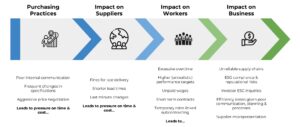The Silver Bullet Everyone Ignores: Responsible Purchasing Practices & Resilient Supply Chains
Let’s cut to the chase – you are an international brand and, like others, child labour, forced labour, and poor working conditions infest your supply chains. Your Sustainability, Purchasing, and Legal teams are in constant corrective action mode. It’s resource-intensive and stressful. Regardless of the market you walk into, your Achilles heel follows, and with it, a sense of déjà vu. Is there a root cause to address?
Purchasing practices are the elephant in the room.
Regardless of your business model, purchasing practices are the elephant in the room. Leveraging their market power to dictate contracting conditions, brands put ruthless pricing pressures on suppliers. After all, suppliers are a dime a dozen – brands know this, suppliers know this, so contracts are a take-it-or-leave-it scenario.
Knowing that they are selected on price and quality, suppliers rely on overtime and subcontracting to remain competitive on labour costs. Material inputs and infrastructure are typically fixed costs, so worker wages and benefits are inevitably undermined by pricing negotiations. The supplier-brand dynamic is so flawed that studies show that products are often made for less than the cost of production. Subcontracting in particular, which is an industry-agnostic norm, fuels this negative feedback loop by outsourcing a brand’s responsibility.
To compete and comply with contracting conditions, suppliers have little choice – they are unable to uphold workers’ rights. Unsurprisingly, labour compliance risks get displaced onto suppliers, and, ultimately, workers themselves suffer (see Figure 1). Caught in the middle, workers are left asking themselves:
How will I meet these increased production targets to provide for my family?
Why are my wages going down when life costs more and more?
Will I be able to get more hours on top of the overtime I already have? I’m already at 100 hours per week.
Will I get paid on time this month and receive missed payments for the past few months?
Trump’s tariffs are set to exacerbate these trends. Experts, like the Institute for Human Rights & Business and Cornell’s Global Labor Institute, warn of COVID-19 flashbacks:
- Sudden order cancellations, reductions, and delays
- Significant worker job loss (at both ends of the chain)
- Suppliers forced to absorb order adjustment costs
- Suppliers dropped overnight
Women and marginalised workers are historically most impacted.
What are responsible purchasing practices & what’s driving the trend?
Investor and NGO scrutiny, legislation, and supply chain insecurity are pushing companies to stare into the mirror and consider responsible purchasing practices. The Ethical Trading Initiative (ETI) defines these practices as:
“…purchasing in a way that enables positive change at the supplier level, so that every part of the supply chain benefits. It requires a trusting, direct and honest relationship where both parties are able to negotiate and share risks equally, and a purchaser who is committed to supporting human rights within the supply base.”
Why do responsible purchasing practices matter?
Reviewing how your practices contribute to these risks goes beyond doing the right thing; it prevents risks to your business (Figure 1). Without taking an honest look in the mirror and engaging suppliers as partners, your supply chain will continue as is – a self-fulfilling prophecy of cyclical compliance breaches and expensive public relations bandages.
Figure 1:

Image Source: Based on Better Buying
Responsible Purchasing is a root cause silver bullet
Purchasing practices are a root cause of human rights issues. From subcontracting and responsible recruitment to forced labour and child labour, these supply chain challenges all link back to purchasing practices. Yes, supply chains are complex; yet, a company has direct control over its purchasing practices. In fact, buyers offering prices that cover at least production costs are associated with nearly 10% higher wages at the supplier level according to the International Labour Organisation (ILO).
Looking for ways to ensure your business model does not encourage these risks? According to ETI’s Common Framework for Responsible Purchasing Practices, key principles include:
- Internal Integration
- Equal Partnership
- Collaborative Production Planning
- Fair Payment Terms
- Sustainable Costing
Here is a set of practical solutions, based on these principles, to inspire your next move:
| Internal Integration | |
| Solution | Impact |
Track and disclose year-on-year quantitative data related to the workers’ rights impacts of purchasing practices. Key data includes:
|
Data monitoring can promote internal awareness, buy-in at a senior level, risk visibility, and opportunities for evaluation and continuous improvement. |
| Train staff to understand the link between their purchasing decisions and non-compliance. Incentivise the selection of suppliers with positive human rights records by aligning staff bonuses with supplier performance. Performance can be tracked with a Balanced Scorecard that assesses suppliers against commercial and ethical criteria. | Raises awareness among staff, which creates the ethical case and the business case, by placing a monetary value on social compliance performance. Both elements guide staff towards responsible purchasing decision-making. |
| Equal Partnership | |
| Solutions | Impact |
| Incentivise long-term relationships with suppliers via multi-year contracts. Suppliers with better human rights performance can be rewarded with longer-term contracts, more business, and fewer audits. | Benefits trickle down to workers through improved contracts, increased employment security, regular payments, reduced overtime, etc. |
Adopt and disclose a Responsible Exit Policy (a.k.a. Responsible Disengagement), which specifies principles and processes. Exit processes should be worker-centric by:
|
Minimises the negative, unintended consequences on workers, including: unpaid wages and benefits, sudden unemployment, etc. |
| Before terminating a sourcing relationship, request suppliers to maintain funds in escrow to facilitate the timely and complete payment of wages and benefits (e.g., social security benefits and termination benefits) to workers.
If the supplier isn’t able to fulfil all wage and benefits responsibilities before the termination, the company can require that any outstanding payments owed to the supplier compensate wages and benefits workers who have become unemployed as a result of the exit. |
Increases the likelihood that workers receive wages and benefits they are owed. |
| Collaborative Production Planning | |
| Solution | Impact |
| Prioritise accurate forecasting and collaborative planning, as well as communication with suppliers. | Helps suppliers plan for the workforce and materials needed, which can prevent sudden unemployment, forced labour, child labour, and reduce input waste as well as the cost of this waste. Furthermore, risk and accountability are more evenly distributed across both parties. |
| Fair Payment Terms | |
| Solution | Impact |
| Ring-fence labour costs during pricing negotiations that account for inflation and rising expenses. | Prevents suppliers from competing by lowering worker wages and benefits. |
| Commit to responsible purchasing practices in supplier contracts. Practices to specify include: pricing, order changes, providing reasonable financial and non-financial assistance to suppliers, assisting in providing remedy to affected rightsholders, and payment terms that ensure timely supplier payments.
(Note: Inaccurate technical specification from the buyer is linked with 22% lower wages at a supplier level, which gets passed onto workers.) |
Helps suppliers plan resources effectively. Promotes shared responsibility to uphold workers’ rights in supply chains. Allows suppliers to cover labour costs and pay workers on time. Fosters supplier trust – the basis for a long-term business relationship. |
| Sustainable Costing | |
| Solutions | Impact |
| Pricing that reflects the cost of fair wages, required overtime, social security contributions, and the cost of implementing the company’s commitments (e.g., costs of responsible recruitment of migrant workers). | Covers the full cost of production, which prevents suppliers from being cornered into breaching social and environmental standards. |
| Pay supply chain workers a living wage. Disclose which living wage methodology is used. | Promotes a decent standard of living for workers and reduces the risks of exploitative working conditions, including forced labour. |
Convinced, but need a hand?
Our team at The Mekong Club knows that most companies face labour rights risks in their supply chains. With many years of on-the-ground experience in Asia, alongside some of the world’s largest multinationals, our community encourages collaboration, best practice sharing, and cross-industry responses to these issues through:
- Corporate Membership
- Modern Slavery Baseline Assessment
- Expert consultations
- Policy reviews, including responsible exit, supplier CoC, etc.
- Closed-door working groups
- Online tools and E-learning
- Supplier trainings
- Staff trainings
- Advisory Services
Interested in learning more or partnering with us? Reach out to Clemence, our Programme Director, on LinkedIn or by email (mailto:[email protected]).
For additional information on responsible purchasing practices, check out:
- Responsible Sourcing Journey, Aim Progress Guide, 2025
- Responsible Purchasing Practices and US Tariffs, ETI, 2025
- Responsible purchasing practices – Manufacturing case studies, ETI, 2025
- E-Learning Purchasing Practices, Better Buying
- Common Framework for Responsible Purchasing Practices in Food, Ethical Trading Initiative, 2024
Author: Tess Zinnes-de Risi, Senior Advisor, Advisory Services at The Mekong Club

